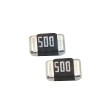The material selection of alloy resistors directly affects their resistance characteristics, temperature stability, anti-interference ability, and applicable scenarios. According to the differences in alloy composition and performance, mainstream materials can be divided into the following seven categories, each with unique physical properties and application focus:

1、 Mainstream alloy resistor materials and characteristics
Manganese copper alloy (MnCu)
Characteristics: Low resistivity (commonly ≤ 4m Ω), low temperature drift (± 20ppm/℃), high stability, strong resistance to pulse current.
Applicable scenarios: ultra-low resistance requirements (such as current sampling circuits), precision instruments, power management modules.
Limitations: High cost, limited high resistance applications.
Iron chromium aluminum alloy (FeCrAl)
Features: High temperature resistance (up to 1400 ℃), strong oxidation resistance, high power density, low cost. But there is parasitic inductance, and the low-temperature drift performance is average.
Applicable scenarios: Power resistors (resistance ≥ 4m Ω) for heating equipment, industrial motors, and automotive electronics.
Copper alloy (CuNi)
Features: Low temperature coefficient (± 40ppm/℃), corrosion resistance, good welding performance, wide resistance range (1m Ω -10 Ω).
Applicable scenarios: General current detection, home appliance control board, medium power circuit.
Nickel copper alloy (CuNi)
Features: No parasitic inductance, wear resistance, excellent high-frequency characteristics, resistance covering the conventional range (1m Ω -1 Ω).
Applicable scenarios: high-frequency switching power supplies, communication equipment, precision circuits that require low noise.
Nickel chromium alloy (NiCr)
Characteristics: High electrical resistivity, high mechanical strength, corrosion resistance, but high temperature coefficient (± 50~100ppm/℃).
Applicable scenarios: high temperature environments (such as engine sensors), corrosion-resistant demand scenarios (chemical instruments).
Karma alloy
Characteristics: It combines the stability of manganese copper with the temperature resistance of iron chromium aluminum, but contains precious metals (such as platinum) and has extremely high cost.
Applicable scenarios: aerospace, high reliability military equipment, with minimal usage.
Ceramic alloy
Features: High resistance (up to 0.75 Ω), good heat dissipation, low cost, but weak resistance to surge current.
Applicable scenarios: consumer electronics (such as mobile phone fast charging), small and medium power voltage divider circuits.
2、 Comparison Table of Key Performance of Materials
The following table summarizes the core parameters of the main materials to help you quickly select:
|Material type | Typical resistance range | Temperature coefficient (ppm/℃) | Main advantages | Typical application scenarios|
|Manganese copper alloy | ≤ 4m Ω | ± 20 | Ultra high stability, low temperature drift | Precision current sampling, BMS system|
|Iron chromium aluminum alloy | ≥ 4m Ω | ± 50~100 | High temperature resistance, low cost | Industrial heaters, automotive power modules|
|Copper alloy | 1m Ω~10 Ω | ± 40 | Corrosion resistant, easy to weld | Home appliance control board, power adapter|
|Nickel copper alloy | 1m Ω~1 Ω | ± 30 | No parasitic inductance, excellent high-frequency characteristics | Communication power supply, high-frequency converter|
|Nickel chromium alloy | Conventional range | ± 50~100 | High mechanical strength, corrosion resistance | Engine sensors, chemical instruments|
|Kama alloy | Conventional range | ± 15 | High stability+temperature resistance | Aerospace and military equipment|
|Ceramic alloy | High resistance value (≤ 0.75 Ω) | ± 100~300 | Good heat dissipation, low cost | Consumer electronics, voltage distribution|
3、 Selection suggestion: How to match materials according to requirements?
Ultra low resistance and high-precision scenarios → Optimal selection of manganese copper alloy (such as current sampling in battery management systems);
High temperature&high-power scenarios → Iron chromium aluminum alloy (industrial motors) or nickel chromium alloy (automotive exhaust sensors);
Cost sensitive consumer electronics ->ceramic alloy (mobile phone charger) or iron chromium aluminum alloy (home appliance control board);
High frequency&anti-interference requirements → Nickel copper alloy (5G base station power supply);
Extreme environmental reliability ->Kama alloy (satellite circuit) or constantan alloy (marine equipment).
The material of alloy resistors directly defines their role in circuits: manganese copper and Kama are based on precision, iron chromium aluminum and nickel chromium are known for their temperature resistance, constantan and nickel copper balance universality and performance, and ceramics focus on cost-effectiveness. In actual selection, it is necessary to comprehensively evaluate the resistance requirements, temperature drift tolerance, power load, and cost budget in order to maximize circuit efficiency and lifespan. If you need to further understand the process details of a certain type of material (such as parasitic inductance control or welding process), you can refer to the technical manual of a professional manufacturer.
